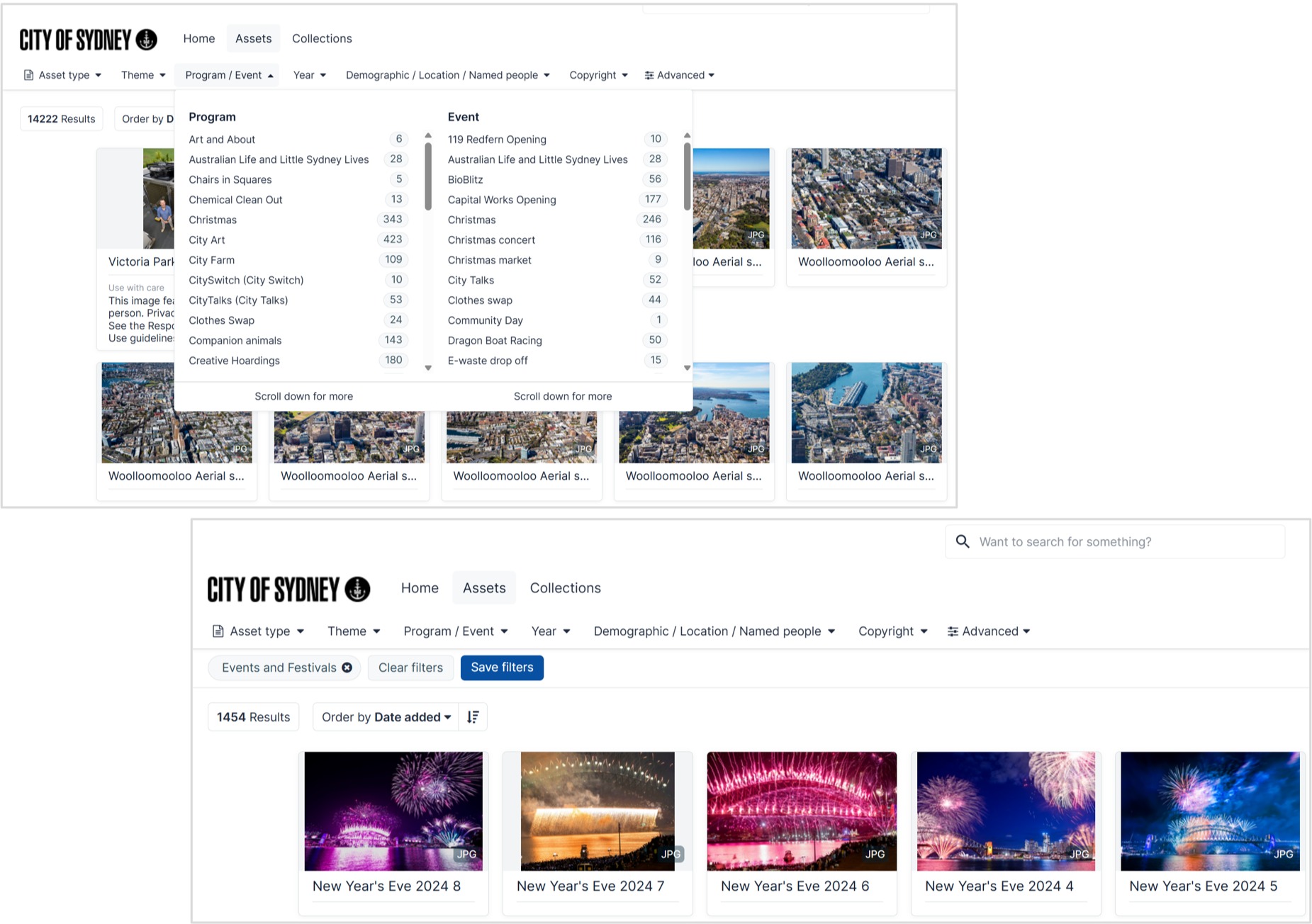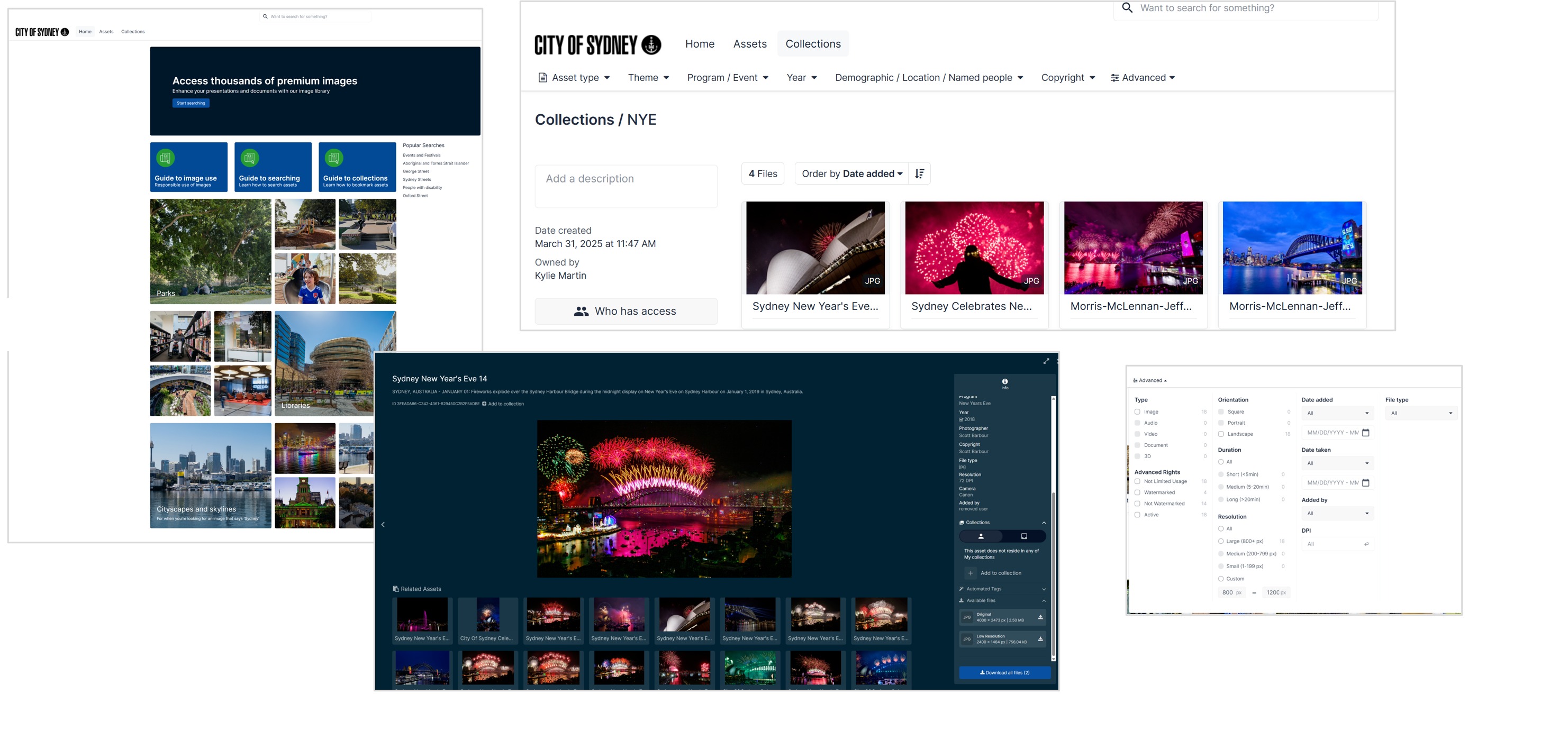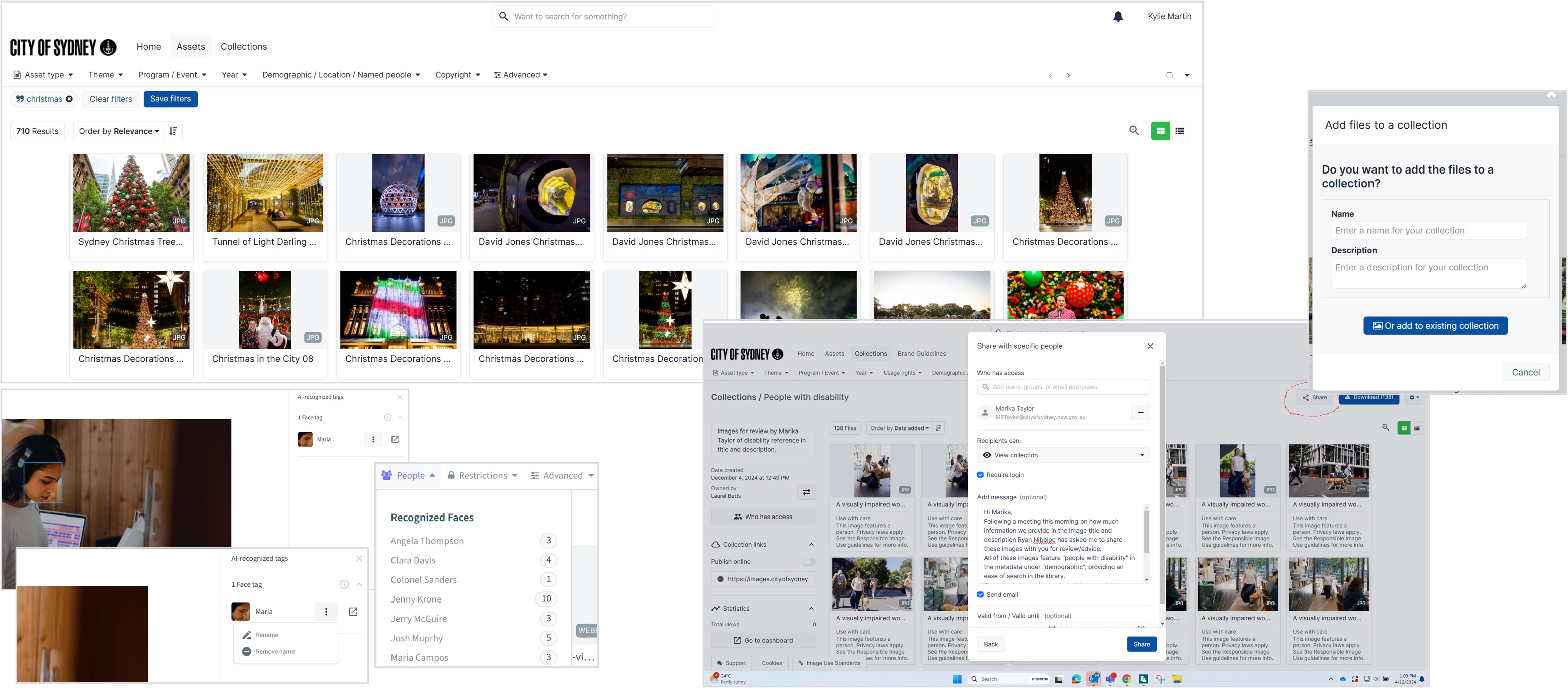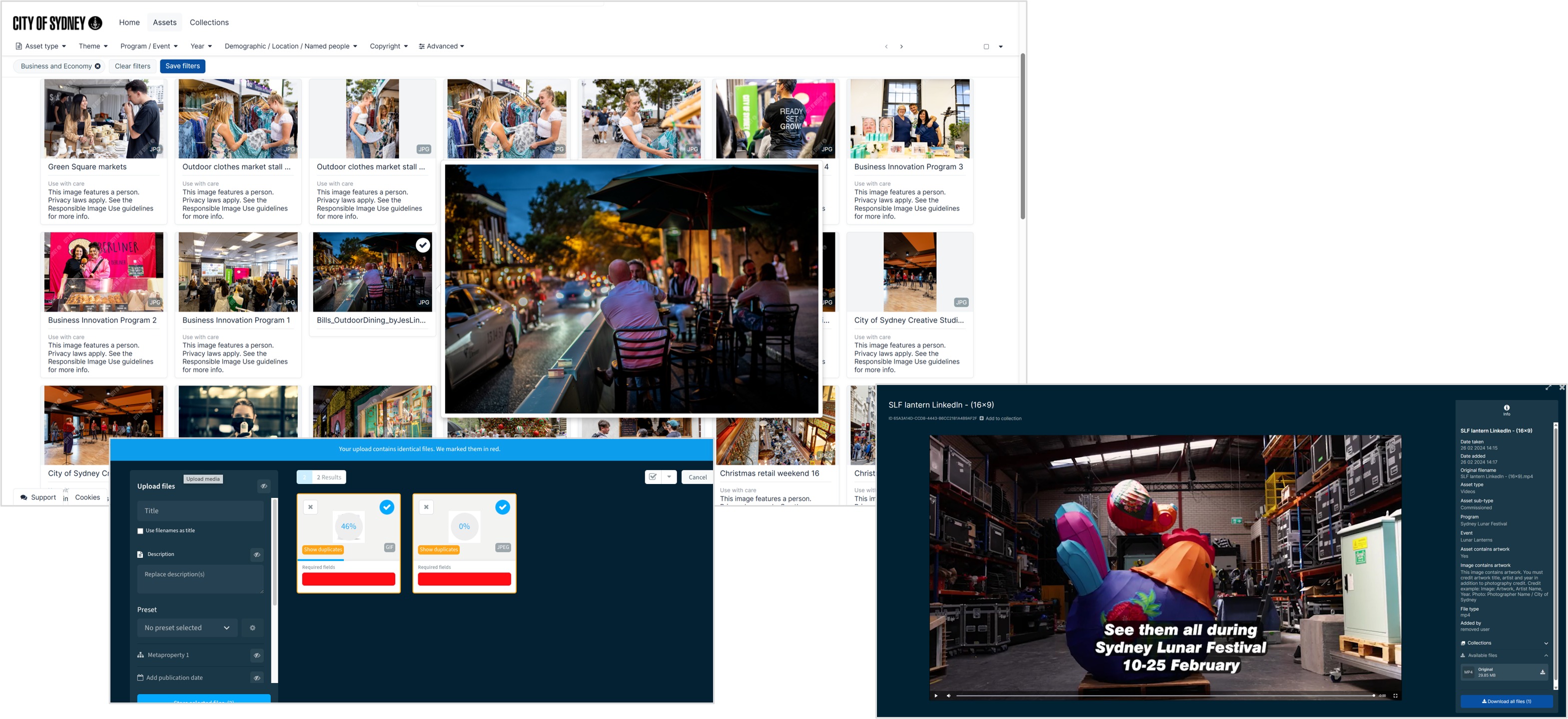



Image Credit : City of Sydney
Project Overview
The Digital Asset Management System (DAMS) is a secure, cloud-based platform that helps the City of Sydney centralise, manage and share its visual identity: photos, videos, and digital media used across tourism, events, sustainability campaigns and public communications.
Previously, staff relied on an outdated system or stored assets on personal drives, making it difficult to locate, protect or reuse content. The new platform transforms this process, using artificial intelligence to automatically tag content, identify faces and objects, and deliver precise search results in seconds.
Built on the Bynder SaaS platform and configured to City workflows, the DAMS integrates approval, licensing, and image transformation tools, allowing users to instantly download media in the correct size or format. Azure Active Directory single sign-on ensures secure access for both internal teams and approved external suppliers.
Launched in March 2024, the system has already consolidated over 110,000 files into a curated, high-value library of 15,000 assets. Staff adoption has exceeded 90%, with average search attempts reduced by 75%.
More than a repository, DAMS empowers smarter storytelling, strengthens brand governance, and protects cultural content for future generations.
Organisation
Team
Project Manager: Kylie Martin, Technology & Digital Services
The DAMS project was delivered by a cross-functional team of approximately 1012 core contributors across Technology & Digital Services, City Communications, and Governance, supported by SaaS vendor Bynder.
Project Brief
The City of Sydney needed a solution that would solve a critical digital challenge - how to find, protect, and reuse millions of dollars’ worth of visual media spanning decades of civic life. Staff struggled to locate assets quickly and safely, leading to lost productivity, unnecessary reshoots, and inconsistent branding.
Enter DAMS: a user-first platform designed to deliver trusted content at speed.
This project wasn’t just about replacing old technology. It was about restoring confidence in the City’s digital memory. The team set out to deliver a platform that was intuitive, intelligent, and secure - one that could scale, adapt, and support a wide range of users, from heritage officers and marketing teams to agencies and photographers.
AI-powered features were prioritised to eliminate manual tagging and guesswork. Real-time workflows were created to enforce rights management and licensing. Integration with the City’s identity system ensured secure access on any device, without creating a new support burden for IT.
The result is a platform that doesn’t just store content - it actively interprets it, transforms it, and protects it.
By designing around user needs, configuring rather than custom-building, and embedding governance into every interaction, the City delivered a future-proof platform that turns digital clutter into civic value.
Project Need
Prior to DAMS, the City’s digital content was scattered across unsupported systems, ageing servers, and personal folders. Staff often needed multiple searches or workarounds to locate assets. Internal surveys revealed more than 70% struggled to find what they needed, often resorting to storing their own versions - creating duplication, legal risk, and inefficiency.
The DAMS initiative addressed this with an innovative, AI-enhanced platform that brings new outcomes to the public sector:
- Facial/object recognition: Auto-tagging reduces manual effort and enables hyper-specific searches
- Curated library: Legacy files reduced from over 110,000 to 15,000 high-value assets
- Real-time transformation: Users download media in any size or format, eliminating the need for editing software
- Rights-aware workflows: Licensing information and approval steps are embedded before any download occurs
While many councils use basic storage tools, DAMS sets a new bar by treating digital assets as dynamic, governed content. The system actively interprets each file, extracts metadata, and learns over time.
By choosing a configurable SaaS model (Bynder), the City gained advanced functionality with minimal overhead - no custom code, no heavy maintenance.
DAMS is a rare example of a local government platform that combines machine learning, design thinking and enterprise-grade governance in one seamless experience.
User Experience
DAMS was built around one principle: make the process of finding and using the right image as fast and intuitive as possible.
The design team conducted workshops with staff across Communications, Events, Heritage and IT to understand daily workflows and frustrations. User feedback revealed pain points like excessive search attempts, duplication, and lack of trust in asset accuracy.
Key experience features include:
- Visual-first interface: Large previews, hover interactions and clear download buttons
- AI tagging: Assets are tagged automatically, so users don’t have to guess filenames
- Search performance: Average queries reduced from eight to two
- Access anywhere: Secure sign-on via Azure Active Directory from any device
The onboarding experience was streamlined using single sign-on and contextual help. Within weeks of launch, 90% of users had adopted the platform. Staff report saving hours previously lost to asset hunting and file formatting.
One user noted:
“Before DAMS, I’d waste half a day tracking down a photo. Now it’s ready in under a minute, and I know it’s the correct version.”
External agencies also benefit from the experience. Secure portals let photographers and creatives upload directly into workflows, reducing delays and back-and-forth email chains.
By aligning user experience with both creative needs and governance requirements, DAMS proves that public sector systems can be elegant, efficient, and empowering.
Project Marketing
DAMS was promoted internally through targeted onboarding, training sessions, and direct outreach to frequent media users across the organisation. This helped drive rapid adoption and build early momentum.
Key engagement outcomes include:
- 90%+ adoption within first weeks
- Increased collaboration - external contributors now use secure upload portals
- Consistent brand application with rights-managed assets used across teams
Rather than treating this as a pure tech rollout, the project team framed DAMS as a core storytelling tool. Teams across marketing, tourism, sustainability, and public affairs were invited to participate in onboarding sessions tailored to their use cases.
DAMS is now integral to delivering faster, more consistent content for campaigns, reports, and events. For example:
- Marketing teams use it to reuse visual assets across multiple channels, reducing duplication
- Event teams rely on the library to quickly source past coverage and update materials
- Sustainability teams use heritage photos in climate change messaging and outreach
With personal drives decommissioned, staff now rely entirely on DAMS as their single source of truth. The system also acts as a quiet brand guardian, ensuring content adheres to licensing and quality standards before it ever leaves the platform.
As a result, DAMS isn’t just managing content, reshaping how the City produces, shares, and protects its visual communications.
Project Privacy
Privacy and governance are core to DAMS by design, not an afterthought.
The system is hosted in the cloud on Bynder’s secure infrastructure, with data residency aligned to Australian standards. All users are authenticated through Azure Active Directory, with role-based permissions governing access to content.
Key safeguards include:
- Single Sign-On (SSO): Only authorised staff or approved external contributors can access the platform
- Granular permissions: Different teams and roles can access specific folders, preventing overexposure
- Audit trails: Every asset interaction is logged and reviewable
- Approval workflows: Only brand-compliant and licensed assets are downloadable
- Metadata tagging: Rights and licensing data are embedded in every record
No personally identifiable information is stored in the platform unless expressly included in metadata (e.g. named event participants). Sensitive content is either excluded or permission-restricted.
During project design, privacy-by-design principles were applied in consultation with the City’s governance and information security teams. The system underwent internal security reviews and testing before go-live.
By integrating policy, technology and design controls, the City ensured that DAMS supports not only creative freedom but also public trust, reputational risk management and long-term accountability.
Digital - Government Services
The provision of timely government services has been transformed as applications and sites are developed and implemented to either replace or complement previous methods. Be it the delivery of current and up to date critical information, compliance, community support and engagement, notification and registration or providing greater accessibility to government resources.
More Details

